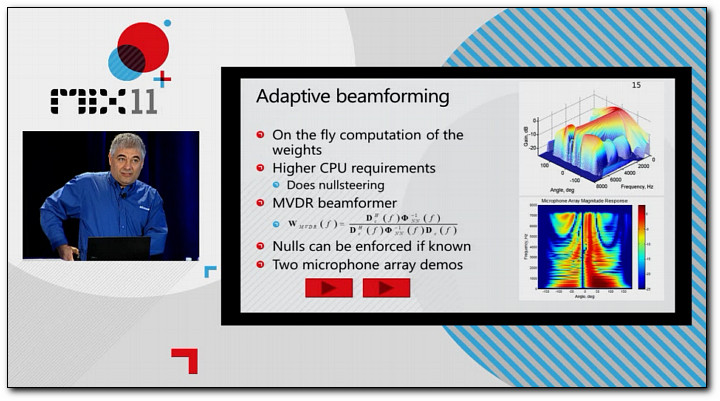
It allows to keep PV going, with more focus towards AI, but keeping be one of the few truly independent places.
-
While most of video related news come these days from NAB, most developers are focused at MIX 11.
I reccomend to have a look at Kinect audio related session:
http://channel9.msdn.com/Events/MIX/MIX11/RES01
Specifically at techniques used to get very high directivity using microphone array and very smart software.
If we'll take consumer and prosumer cameras this is their future that'll come to reality in next few years. -
Impressive ! :) It is very similar to line array in PA systems but in the opposite direction.
-
Mike array will be the real future.
As well as the depth sensors integrated into the camera.
Perfect next gen camcoders will have about 20-25 electret mikes, one-two depth sensors (with about 800x600 res) and eye tracking. So you just slide your finger slightly to sensor area and camera start tracking your view instantly focusing on necessary object and picking highly directional sound from it :-) -
I think its a river topic :). We have many issues. Directivity, noise cancellation, sound quality, stereo or surround imagination etc. We are living in very interesting times :). I'm sound engineer in small studio and PA systems and I know that sound is always compromise between people, technology and environment :).Simple array is combining two directional mics parallel as close as you can in the same direction and we have got twice efficiency from the front of mics ( its look like A-B ).In post processing it needs convert two channels to mono.
-
People have been theorizing that arrays are the future for more than twenty years, but now I see some real progress. There is some very interesting work in Germany now for almost a decade with real industrial applications. I think you will start to see some useful products that move beyond theory. Whether they put it in a camcorder is another story. Manufacturers deliberately put crap audio in the camcorders so they can sell accessories. For $20 in parts they could put five "Zoom H2 or better" capsules in a camcorder with 24 bit audio and surround option. But they don't do this, of course. Look for an "add on" mic with somewhat better capabilities, or for a second tier like JVC to make the jump before Canon and Sony.
One of the simplest arrays is the rubber band combo. For example, take two pairs of of omni and cardioid, or omni and hyper, and tie them together with rubber bands, so they act like one mic but do not vibrate. Then you have a virtual mic with different colors, even more flexible than the Sennheiser MKH 800 twin if you use mics with interchangeable capsules. You can also take a dual capsule mic and wire each capsule separately and create your own Neumann type multipattern, but the rubber band system for now is the fastest and cheapest way, and you can tie even eight mics into 4x2 or 2x4 arrays.
One array I like very much is tieing a Sennheiser MKH40 with a Schoeps MK2H or a Schoeps MK21. Also the Schoeps MK41 tied to a DPA 4003.
-
They used a version of this for military use spotting sniper positions
Howdy, Stranger!
It looks like you're new here. If you want to get involved, click one of these buttons!
Categories
- Topics List23,992
- Blog5,725
- General and News1,354
- Hacks and Patches1,153
- ↳ Top Settings33
- ↳ Beginners256
- ↳ Archives402
- ↳ Hacks News and Development56
- Cameras2,367
- ↳ Panasonic995
- ↳ Canon118
- ↳ Sony156
- ↳ Nikon96
- ↳ Pentax and Samsung70
- ↳ Olympus and Fujifilm101
- ↳ Compacts and Camcorders300
- ↳ Smartphones for video97
- ↳ Pro Video Cameras191
- ↳ BlackMagic and other raw cameras116
- Skill1,960
- ↳ Business and distribution66
- ↳ Preparation, scripts and legal38
- ↳ Art149
- ↳ Import, Convert, Exporting291
- ↳ Editors191
- ↳ Effects and stunts115
- ↳ Color grading197
- ↳ Sound and Music280
- ↳ Lighting96
- ↳ Software and storage tips266
- Gear5,420
- ↳ Filters, Adapters, Matte boxes344
- ↳ Lenses1,582
- ↳ Follow focus and gears93
- ↳ Sound499
- ↳ Lighting gear314
- ↳ Camera movement230
- ↳ Gimbals and copters302
- ↳ Rigs and related stuff273
- ↳ Power solutions83
- ↳ Monitors and viewfinders340
- ↳ Tripods and fluid heads139
- ↳ Storage286
- ↳ Computers and studio gear560
- ↳ VR and 3D248
- Showcase1,859
- Marketplace2,834
- Offtopic1,320
Tags in Topic
- audio 88
- sound 80
- mike-array 1






